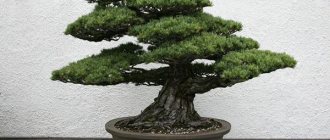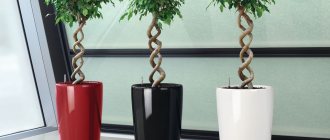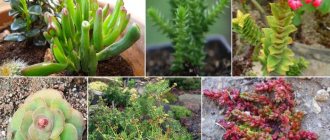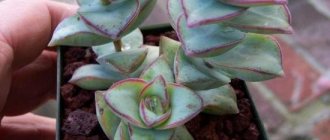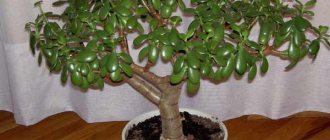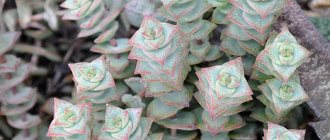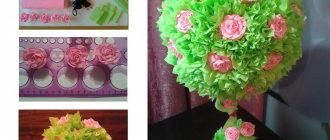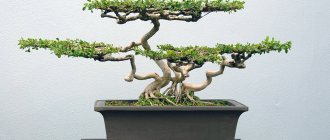Money tree (crassula): home care, signs and superstitions, medicinal properties
Crassula (Crássula) means “fat” in Latin.
The representative of the flora belongs to the genus of succulents, the Crassulaceae family. Crassula comes from South Africa and is native to the Southern Hemisphere. The money tree was brought to Europe in 1687. The plant spread with incredible speed throughout all countries. The succulent easily adapted to indoor growing conditions and was loved for its beautiful crown and easy care.
In nature, the height of the perennial varies depending on the species: from a few centimeters to four meters.
The root system of the perennial consists of a central short root, from which many lateral roots extend, located close to the soil surface.
Young shoots branch off from the erect, lignified trunk, forming a tree-like crown. The color of the trunk is brownish-brown, the color of young branches is green.
Crassula flowers are small, collected in umbrella inflorescences. Their color is usually white, sometimes a pinkish tint is noted. Flowers are formed at the end of the shoot or in the axil of the leaf. Flowering lasts for about three months. The flowering tree exudes a sweet aroma. To prevent Crassula from wasting energy on seed ripening, faded inflorescences are usually cut off.
How to grow a miniature Crassula tree with your own hands?
When working with an adult Crassula, you will have to subordinate your ideas to the original size of the plant. By growing a tree from a sprout, you can form the most interesting forms of bonsai.
But in the latter case, you will have to wait until the Crassula stem becomes woody.
Signs and superstitions
The money tree has a number of other popular names: the tree of friendship, the tree of luck, the tree of life. The plant is grown to attract money, choosing the most honorable and bright place in the room. It is advisable to plant a flower and grow it yourself from a cutting, rather than purchasing a ready-made one.
Folk omens say: to attract money to the house, you need to bury three coins under the roots of the fat plant. And in order for financial well-being to be stable, hang banknotes on the branches, which must be periodically replaced with new ones, while the old ones must be spent.
In addition to signs associated with money, it is believed that perennials improve the vital aura of a home, attracting positive energy. In addition, it has healing properties and purifies the air in the room. The leaves of the succulent secrete phytoncides that have protective antiviral and antibacterial properties.
An exceptionally healthy tree can possess such positive qualities. If the fat plant sheds its leaves, then this symbolizes monetary losses and financial difficulties. To avoid this, you need to properly care for the tree.
Types and varieties
The species diversity of Crassula is great - more than 300 species. Some varieties are cultivated only in greenhouses, while others are grown exclusively indoors.
In home floriculture, fat plants are divided into 3 groups:
- tree-like;
- spicate or columnar;
- creeping or ground cover.
Each group is rich in its varietal diversity.
The most commonly grown species by gardeners. Miniature trees with a beautiful curly crown on a thick stem are a decoration for any interior.
Let's look at the most common varieties.
How to trim step by step?
This procedure is usually carried out in the spring.
Progress:
- Full pruning of branches is done above the brown rings (leaf scars) that are located around the stem.
- The cut should be straight. If after pruning there are depressions and scars left, they will cause the succulent to rot.
- When cutting a 6–9 cm branch, leave one or three pairs of leaves at the tips of the stems (this depends on their location in the crown).
- There is no need to trim all the branches in one go. It is better to take weekly breaks so that the fat woman can rest.
To control the density and shape of leaf buds, it is recommended to lightly pinch the Crassula, approximately 1–2 times every 7 days. You should pinch off overly large leaves, as well as leaf buds growing in the lower zone of the succulent.
Weekly pinching (pinching) of the branches will stimulate the development of the remaining buds. The leaves that emerge from them will be miniature. The growing succulent will become more and more like a dwarf tree.
Long branches need to be trained to the chosen direction. For this purpose, it is recommended to use copper wire. It should be soft. Carefully bend the copper to form the intended shape of the crown. After 3 weeks the result will be noticeable.
This video shows how to make a money tree bonsai using wire.
Formation of the crown and trunk of the Crassula. Trimming and pinching
How to form a crown? How to form a Crassula trunk? How to properly prune a potted money tree at home? How to pinch a fat woman? Let's answer these questions.
trim and pinch the ends of the shoots
Is it possible to prune the fat plant? How to trim the branches of a money tree so that it grows into a stem? Prune the crassula just above one of the brown rings around the stem, called a leaf scar, with sharp pruning shears or a knife. New shoots will grow at the site of the cut, so choose the stem you want to cut carefully.
Your choice will depend on where you want the trunk to be thicker and the foliage to be denser. This method is good for old plants that have heavily developed stems and little foliage.
Cut bulky branches with pruning shears or small, sharp-edged scissors to achieve the desired tree shape. Do this in stages if necessary, giving the plant a chance to rest between trimmings. This way you can better imagine the shape of the crown.
Remove large leaves to allow light to reach the inner parts of the canopy where you want new leaves to grow. The cuts should be neat and straight. Pits and scars can cause rot.
Lightly trim once or twice a week to keep leaf bud size and density under control. Pinch off overly large leaves or leaf buds growing in undesirable places, such as the bottom of the trunk. Use long tweezers to remove cut parts.
Photo of how to form the crown of a money tree (formation example).
Do not use garden varnish. Instead, let the cut pieces dry and form a film. Pathogenic bacteria can penetrate the garden varnish and cause rotting. Sterilize tool blades with alcohol after each pruning to prevent disease, especially if you are working with multiple plants.
Pinch the tip of the stem with your thumb and forefinger to remove it. Decide how you want the fat plant to look in the future so you can choose the right site. Two new stems will appear at the pinching site. This method is good for young plants or short stems if you want a thicker crown.
Place the Crassula in a sunny location, preferably a south-facing window, where it will receive at least four hours of sunlight each day. The daytime temperature should be between 18 and 23 degrees during the day and between 10 and 13 degrees at night. Protect from drafts. Leaves should not touch the glass or window frame. If you provide the plant with these conditions, its crown will be dense.
in well-drained soilReplant
Water the plant often enough in spring and summer to keep the soil moist but not soggy. In winter, let it dry out between waterings. Water the soil and do not let water get on the leaves of the plant. Providing proper, regular watering helps the trunk and branches thicken naturally.
Photo of how to form a crassula (money tree) into a tree.
Fertilize every three or four months with liquid fertilizer and the crown will become dense.
How to grow crassula yourself?
The easiest way to propagate Crassula is by cuttings. You can use parts cut from an adult plant when forming the crown:
- The cuttings are placed in water, removing the leaves from the bottom (rooting stimulants can be added).
- Periodically check the freshness of the water and add new water if necessary.
- After a week, the Crassula is ready for transplantation.
If you have a lot of cut branches of different lengths, but you want to get one or two plants, you can use an easier method:
- Select straight cuttings.
- Plant them in a bowl filled with moist potting soil.
- Water the soil periodically.
- After a few weeks, when the shoots take root, select the strongest ones and transplant them into a pot.
Soil selection
Crassula is not a demanding plant. To plant it, you can use any universal substrate. Under natural conditions, succulents “manage” to grow even on brackish soils, in regions with low rainfall. They do not like acidic soils.
For Crassula, you can buy any universal soil mixture (soil) or make it yourself:
- Take turf soil (3 parts) and deciduous soil (1 part).
- Add some humus.
- If the soil is heavy and clayey, then you need to add coarse sand.
- Stir the mixture to form a homogeneous soil.
Planting step by step
Before planting or transplanting, the roots are inspected and rotten parts are removed. Excess and bare branches are cut off. When the fat plant is ready for planting, do the following:
- Place the plant in the prepared pot. It should have drainage, sprinkled with soil up to approximately half the container.
- Place the shoot in a pot and secure it with a support wire (you can ask someone to hold the seedling vertically).
- The remaining soil is poured around the stem until 2-2.5 cm remains from the edge of the pot.
- Water generously until water appears in the pan.
- If the soil settles, you need to add a little to the desired level.
After planting, the plant is placed in its designated place.
How to make fertilizing?
The first two to three months after transplantation do not feed. Then you can use any complex fertilizers for succulents or universal fertilizers for the growing season. They are applied one or two days after watering, preferably in the afternoon.
How to fertilize correctly:
- The fertilizer is diluted according to the instructions in rain, boiled or settled water.
- Water the soil until water appears in the pan.
- Excess liquid is drained, otherwise it will begin to rise, which will lead to excessive salinization of the soil. Although the fat plant tolerates high salt content in the soil, even such an unpretentious plant may not survive too high doses. You will have to wash the soil.
In summer, fertilizers are applied once a month. In winter - once or twice a season.
Crassula requires minimal care. You can forget about it for several weeks. The plant will react to lack of care with several yellowed leaves. When leaving, the main thing is not to harm:
- place the pot in a well-lit place. In order for the branches to grow in different directions, it needs to be rotated 2-3 cm every week. Otherwise, new shoots will reach towards the window. This is not so bad if you form a bonsai in an inclined or cascading shape
- provide moderate watering as the soil dries out. It is impossible for moisture to constantly stagnate in the pot. If you pour water once, the fat woman will survive it. But constant dampness will cause the roots to rot;
- in winter, the plant is moved to a cool place. If this is not possible, you need to ensure that the soil does not dry out. Otherwise, the leaves will begin to turn yellow and fall off.
Popular articles What to do as a gardener during quarantine
To prevent the crown from becoming overgrown, it must be trimmed regularly.
Diseases and pests
Crassulas rarely get sick. But sometimes they are affected by insects or infections:
- the appearance of yellow and brown spots on the leaves is a signal of scale insect infection. You need to carefully examine the stems and leaf blades. If there are small (up to 2 cm) dense insects on them, more like dots, then immediate treatment is needed;
- Spider mites are another pest that can settle on Crassula. Insect infestation can be identified by the appearance of yellow spots on the leaves and the spread of cobwebs;
- cotton wool-like coatings on leaves and stems indicate mealybugs.
Insects are destroyed with insecticides. This is the most reliable way to get rid of pests. Since Crassula is not suitable for food, you don’t have to worry too much about environmental cleanliness.
Bacteria and infections rarely affect flora from other regions. In addition to insects, the fat plant is usually only threatened by too much watering. It leads to rotting of the roots. In this case, the plant is dug up. Then the rotten parts are removed and the Crassula is planted in clean soil.
How to grow a miniature Crassula tree with your own hands?
When working with an adult Crassula, you will have to subordinate your ideas to the original size of the plant. By growing a tree from a sprout, you can form the most interesting forms of bonsai.
But in the latter case, you will have to wait until the Crassula stem becomes woody.
Selection of capacity
To create a bonsai from a home plant, it is important to choose the right container. It is advisable to use a special container - low but wide, which will limit the space for the root system of the money tree. A prerequisite is that the pot must have drainage holes
A prerequisite is that the pot must have drainage holes.
Landing
The best soil for Crassula is soil for cacti or succulents. The soil mixture should be loose. Light soil perfectly allows air to pass through, which is important for the full development of the root mass.
To prevent the soil from being washed out of the dishes, you need to cut off several pieces of cellular vinyl mesh, square or rectangular in shape. Size – larger than the bottom of the container. The mesh cells should be smaller than the drainage hole.
Prepare copper wire (7 cm) and make a loop along the edges. Thread the resulting curves into the drainage hole, securing the mesh. In a similar way, attach a piece of wire to the bottom of the container to secure the succulent.
Further progress:
- Prepare Crassula. Clear its root system from the soil.
- Gently untangle the roots and straighten. For convenience, it is recommended to use a crochet hook.
- Trim the roots of the fat plant so that they fit into the selected container.
- Cut off dead areas and those that grow downwards.
- Cut off bare and weak branches of the money tree.
- Use pruning shears with a concave blade to cut off opposite branches.
Pour a small amount of soil into the pot. Place the succulent in a bowl, carefully distributing the root system. Pour the rest of the soil into the container and water it with settled water.
This video shows root pruning and replanting a money tree.
What types of Crassula are suitable?
Crassula has more than 300 species. A healthy Crassula arborescens or Crassula ovata plant is suitable for growing bonsai.
Successful varieties that can be turned into a miniature tree are:
- "Hobbit"
- "Tricolor";
- "Bronze Beauty";
- "California Red Tip".
Attention!
When choosing a succulent, it is important to know that green-leaved crassulas grow much faster than varieties with variegated leaves.
Formation of a money tree
You can start growing Crassula miniatures at any age. But you need to consider:
- a young plant, if properly formed, will allow itself to become anything;
- an adult money tree will dictate the style by the thickness of the trunk and the configuration of the crown.
How to accelerate the barrel
In a bonsai, the main stem should be powerful. To make it thick, special techniques are used. Step by step, using the example of a young specimen:
- Pinch the top of the head. This stimulates the appearance of lateral branches. The operation is best done in the spring, when the money tree is actively growing.
- In young shoots, except for the lower ones, the growing point is regularly removed. All the forces of the plant and plastic substances will be directed to the formation of forks and thickening of the trunk.
- When the branches at the base become long, they are shortened, but not cut off completely.
- As soon as the fat plant grows and the main stem begins to become woody, tops will appear. They inhibit the development of the crown, so they are usually plucked out immediately, but when creating a bonsai, these hatching shoots thicken the trunk.
- Leaves at the base of the plant are not forcibly removed.
- When the money tree becomes powerful enough, the lower part is exposed - thick branches are cut out, plates and tops are plucked out.
Experienced cactus growers do not cover up wounds with anything - the fat woman will heal them quickly. For self-soothing, beginners can sprinkle the sections with crushed activated carbon.
Young Crassula Bonsai
If the miniature is formed from a rooted cutting, the Crassula will look like a bonsai from the very beginning. The owners will have:
- decide on a style;
- leave only the trunk or select a few additional strong branches located in the right place, cut out the rest;
- regularly pinch the tops;
- after the trunk reaches the desired thickness, remove all the tops;
- When the miniature is formed, plant it in a special pot.
Adult Crassula Bonsai
If the plant has a too thin trunk, you need to do drastic pruning. You can remove the top part, leaving one or more columns.
The fat plant will begin to branch. The lower shoots and tops should be left to thicken the base, the upper shoots should be pinched as soon as they grow.
When the trunk is thick enough, you can begin to form a bonsai without drastic pruning. It’s good if there are several powerful branches extending from the base of the money tree - they will make the miniature more interesting.
After removing the “extra” skeletal shoots, the remaining shoots are lightened - the lower part is exposed. All sprouts directed inside the crown are cut out, the apical ones are shortened to 1-5 internodes. On thick main branches, you can save a few thin ones that face outward.
How to Make a Money Tree Bonsai in Different Styles
In the process of work, flower growers will acquire skills and will be able to move on to complex forms, but it is better to start with something simple:
- Broom style. The plant looks like an ordinary garden tree with a rounded or spreading crown on a trunk. The branches extend from the top in different directions. After the thick stem is formed and exposed, the shoots remaining on the crown are pinched and a ball or an inverted cone is made. It's a little more difficult to create an umbrella. For a weeping crown, you will have to bend the shoots using wire.
- Bonsai forked trunk. The standard at the top gives a fork. Skeletal branches must be exposed at the base. You can make them the same height, but a fat plant with two crowns located at different levels looks better. Further formation is similar to the “broom” style.
- Money tree: bonsai group. Several separate plants of different sizes grow in one bowl.
How to bend bonsai branches
The method is used to create a weeping crown. You can intricately bend a separate branch or form a curved trunk of a fat plant.
The selected shoot is wrapped with wire, carefully bent, and fixed in the desired position. You need to wrap it tightly, but not tightly, and make sure that the winding does not grow in. You will have to remove it in parts, cutting with wire cutters.
Wire requirements:
- metal – soft, for example aluminum;
- diameter - a quarter of the thickness of the branch;
- length - one and a half times longer than the shoot.
Methods for pruning a plant
There are several different schemes, the appropriate one is selected based on what shape of the crown the grower wants to get:
A tree with a powerful central trunk
To strengthen this part of the succulent, the young fat plant should be trimmed, removing not only the branching shoots, but also the lower foliage. If you need to strengthen the central trunk of an aged tree, then you need to trim all the shoots and be sure to fertilize it.
It is better to plan the procedure in the spring, before the plant enters a period of active growth. At the end of autumn, it is recommended to pinch out the upper part of the shoots.
Crassula, which has a thick central trunk and a crown of hanging apical shoots
Such formation is possible only if measures have previously been taken to strengthen the trunk of the Crassula. Otherwise, the thin trunk may not withstand the load and break under the weight of branches and foliage.
That is, you should initially pay attention to pruning, thanks to which the trunk becomes large and powerful, and only then leave shoots in the upper part of the succulent
Formation of a compact, low bush
To prevent the flower from stretching out, but turning into a lush, voluminous bush, it is rarely watered and the foliage on the trunk is regularly removed.
Spreading shrub
Forming the crown of a money tree using this type of process is not complicated. To do this, it is necessary to pinch the shoots growing from the apical buds so that the shoots branch from the axils located below the cut.
Some gardeners plant several succulents in one container and then a luxurious bush is formed from their shoots. However, this method is considered inappropriate, since the plants grow and begin to oppress each other, suffering from lack of space and nutrition; their development slows down over time and may stop altogether.
The formation of the crown is affected not only by pruning or lack thereof, but also by the conditions in which the flower is kept.
Home care
Caring for a fat woman is not difficult. Essentially, caring for a money tree includes moderate watering, periodic feeding, removing dust from the leaves, pruning and shaping the crown.
Lighting
The shape of the fat plant can change depending on the intensity of light: with a lack of light, the trunks stretch out and become thin; with too much light, on the contrary, they thicken.
Crassula, or money tree, should be placed in places with sufficient lighting, optimally on the southeast side. This rule is recommended not only by flower growers, but also by Feng Shui experts.
It is important to ensure that direct sunlight does not fall on the flower, which causes the plant’s foliage to turn red, wither and fall. In summer, the tree crassula feels good and comfortable on the balcony, and in the cold season it is better to move the plant to windows facing south
Popular articles Everything you wanted to know about tulips
Watering
How often to water depends on the temperature. You need to water the money tree:
- twice a week - in hot weather;
- once every 7 days – at normal temperature;
- once every 20–30 days – in winter.
The person caring for the plant must ensure that the soil is not excessively wet, but also does not dry out. It is better to water the plant in the evening, with warm, settled water.
Humidity
Crassula tolerates moisture deficit well and does not require regular spraying. Dust accumulated on the surface of the sheet plates can be removed with a damp cloth. Crassula responds well to warm showers, which are carried out once every 2-3 months, covering the ground with film.
Temperature
In spring and summer, the optimal temperature for the plant is from 20 to 25 ° C; it is advisable for the flower to be on the balcony or street - a living tree does not tolerate a lack of fresh air. In winter, the plant is comfortable at a temperature of about 15 ° C or lower, but not less than 4 ° C.
At room temperature, the flower can also overwinter, but its leaves will most likely begin to wither and fall off. It is better not to place the money tree flower near heating radiators.
How to replant a money tree
You can learn how to replant a money tree from experienced gardeners. Transplantation is carried out once every 2-3 years, not more often, and only if necessary - if the flower has grown greatly.
To maintain compact dimensions, you can do without replanting and only replace the top layer of soil in the pot.
The plant is transplanted in the spring (preferably in May) into a pot slightly larger than the previous one. The soil for replanting Crassula is taken from ordinary purchased soil, intended for planting cacti and succulents.
You can prepare such a soil substrate yourself by mixing part turf soil and sand with three parts leaf soil. If you add a handful of humus, clay, ash to the ground, the nutritional value of the soil will increase
In order for the transplanted flower to grow well, it is important not to forget about drainage - expanded clay or crushed shards
The roots of the plant along with a lump of earth are placed in a pot filled with drainage material and a quarter of soil. Then the voids are filled with new soil substrate. After transplanting, the flower is watered well. The soil is periodically loosened to improve oxygen supply to the roots, and if the soil sags, the top layer is added to the pot.
How to trim Crassula
To create a beautiful decorative look, you need to trim the money tree. The formation of the flower crown begins while the tree is still young. When the height of the fat plant reaches 15–20 cm, pinch off the two small top leaves. As a result, branching will begin in this place, and four leaves will appear instead of two. As Crassula grows, the top leaves are removed in places where shoots are expected to branch.
Is it possible to trim the stems and leaves of an adult plant? It is possible, but in this case, stumps remain in place of the truncated shoots, spoiling the appearance of the Crassula.
What is bonsai and what are the basic principles of its formation
This is the name of the art of growing a miniature copy of a tall or dwarf tree. Experts calculate the scale of reduction; beginners only need to know the basic techniques and rules. Plants grown using the bonsai technique reach a height of 5-200 cm. At the same time, they have a thick trunk with curvatures and thickenings characteristic of a mature tree. The leaf plates are smaller, which gives the flower the most realistic appearance.
Principles of forming a tree in bonsai style:
- naturalness, harmony;
- sufficient fresh air;
- container with drainage holes;
- regular formative pruning;
- stopping the growth of some shoots and accelerating the development of others;
- periodic feeding;
- growing a thick curved trunk;
- moderate watering.
How to form a crown
When pruning a tree and shaping the crown, it is important to keep in mind the intended shape of the tree. To make your bonsai original and attractive, it is important to decide which branches will develop
It is necessary to start decorating the crown when 6-8 leaves are formed on the branches. Usually they begin to form the crown of a bonsai in the spring, for this they do the following:
- completely cut off the branches above the brown rings, they are located around the stem;
- the cut is made straight, and if scars and indentations remain after pruning, then because of them the fat plant may begin to rot;
- if a branch 6-10 centimeters long is cut, it is necessary to leave one or three pairs of leaves on its edge, depending on its location on the tree;
- You should not cut many branches at one time. It is advisable to take short breaks, about 1 week, so that the tree has time to rest.
To control the shape and density of leaf buds, experts recommend pinching once or twice a week. Leaf blades that are too large are pinched off and those leaf buds that grow in the lower part of the trunk are removed. Thanks to weekly pinching, the remaining buds will develop more intensively, and the leaves emerging from these buds will be tiny. As a result, the tree will become increasingly miniature.
Trimming
You need to trim the succulent with a sharp knife or scissors. Before each circumcision, the working surface of the instrument should be sterilized with alcohol . This will protect the fat plant from diseases, especially if several plants are processed.
Formation of a thick trunk
To obtain a powerful trunk, you need to grow tops on the plant. First, you should grow long branches. When they reach the desired thickness, their excess length should be cut off .
The cut site will heal over time. A thick top with new shoots forms on it. During the growth of the top, the branch is not cut, but the main shoots are cut off every year.
Advice!
If the branches have grown long, they should be cut off. Regular pruning of branches gives more energy to the trunk, as a result it begins to thicken.
It is necessary to remove too large leaves from the fat plant, as well as those that grow at the bottom of the crown. This technique will facilitate access of light deep into the trunk.
How to form a crown yourself?
When creating a crown, you need to take into account the intended shape of the future tree. It is important to identify the stems that need to be developed into a bonsai branch. You can decorate the crown when 3–4 pairs of leaves appear on the branches.
This video shows how to grow a thick stem in a fat plant and form a crown
Content Features
Why does an ornamental money tree at home turn into a sloppy, ugly plant with crooked, thin and long branches? Perhaps we are talking about a violation of the conditions of care and maintenance of this tropical inhabitant. Thus, thinning and elongation of succulent branches often occurs due to excessive watering and lack of light.
Overwatering can be called the most dangerous mistake a gardener makes, due to which succulent vegetation dies. Being in waterlogged soil, the rhizome of the succulent becomes infected with rot and dies, and excessive saturation of the trunk with moisture leads to disruption of its structure and further damage.
The correct selection of container is also important for the correct formation of the bush. If it grows in a shallow, wide pot, it produces a large number of lateral shoots and does not stretch upward.
Where to start forming a tree?
Selection of pot
The diameter of the pot for the fat plant is selected according to the size of the crown: slightly larger than its diameter. As the plant grows, the width of the container needs to be increased. A tree with a voluminous, fleshy crown will become more stable. Ideally, a money tree pot should be wide, heavy and flat. A drainage layer is laid out at the bottom.
Not every pot is suitable for a fat plant. Its root grows close to the soil surface. Therefore, a shallow pot for rooting is suitable. The tap root of a crassula in a deep pot tends downward, and the stem tends upward, while thinning and weakening.
The soil
The soil for Crassula is light, loose, and porous. The money tree does not like fertilized and fertile soil. The substrate for Crassula should include humus, sand, leaf and turf soil.
Home care
When forming the crown and growing Crassula, much attention is paid to location and lighting. Crassula prefers bright light, but direct sunlight will cause the leaves of the flower to turn red. If there is not enough light, the stem will stretch, the branches will bend, and the crown will lose its symmetry. For this reason, it is recommended to rotate the flower periodically. At the same time, do not forget about the fragility of the branches.
Careless handling of the plant will lead to breaking off of the fleshy, heavy branches.
The tree-like fatty plant does not need frequent and abundant watering. Thick and fleshy leaves of the flower are able to accumulate moisture
Crassula is one of those plants that is better to underwater than overwater. It is more demanding when it comes to wiping leaves and general spraying. Clean leaves are saturated with oxygen and become elastic.
When grown in an apartment, Crassulas branch weakly and grow long and thin. Therefore, the crown and trunk of the money tree are formed.
You will find more information about the rules for caring for a fat woman here.
Technique for growing a miniature tree
Bonsai, or literally “grown in a tray,” is an amazing plant growing technique that allows you to form compact miniatures from home flowers. And having learned the basics of this art, you can form a bonsai even from the usual fat plant with your own hands, if you know how it’s done.
You can use an adult plant, but in this case you will have to base it on the size of the existing specimen. But when growing a tree from a sprout, you can give more free rein to your imagination and create bonsai of the most bizarre shapes. But, in the latter case, it will take time for the stem to lignify.
Selection of pot
To get a miniature one from an ordinary money tree, you need to choose a suitable tank. It should be low and wide, which will limit the space for the plant’s rhizome and prevent it from growing larger than necessary. A prerequisite is the presence of drainage holes in the bottom.
Preparatory moments and planting process
For Crassula bonsai, you should prepare a soil mixture that is intended for cacti and succulents
This substrate has the necessary looseness and breathability, which is important for the full development of the root system.
In order to prevent the soil from being washed out, you need to place pieces of vinyl mesh at the bottom of the pot. Squares or rectangles are cut out of the material, larger than the bottom of the container.
Loops made of copper wire are attached to the drainage holes, the length of the segments is 6-8 cm. With the other end they are attached to the edges of the mesh, securing it. In the same way, you can attach a piece of wire to the bottom, with which the succulent is fixed.
The “money” tree itself also needs preparation:
- The plant is prepared, its root system is freed from the soil.
- The roots are carefully untangled and straightened. The most convenient way to do this is with a crochet hook.
- The roots are trimmed so that the rhizome can fit into the selected pot. It is imperative to cut off dead parts of the root system and roots growing downward.
- Then the above-ground part of the fat plant is subject to pruning, weakened and leafless branches are removed. Using pruning shears with a concave blade, cut off the opposite branches.
Then a little soil mixture is poured into the pot, in which the plant is placed, the roots should be straightened. The container is filled with the rest of the soil and watered with settled water at room temperature or a little warmer.
Possible difficulties and common mistakes
To avoid difficulties when growing money tree bonsai , you must follow the following recommendations:
- cuts should not be covered, as this will provoke the development of putrefactive processes. It is better to dip the cut into charcoal powder;
- When watering the ground, you need to make sure that water does not get on the leaves of the money tree ;
- If there is a need to replant the succulent, then do it every few years. It is recommended to replant a young succulent no more than once every 2 years, an adult plant - once every 3-5 years.
- When replanting a money tree, you should inspect the root mass . Soft or dark roots should be cut off and the soil replaced.
Carefully!
Frequent repotting can have a negative impact on the succulent, slowing down its growth.
Using the above tips, you can form a real bonsai from Crassula; this miniature tree will become an exotic decoration for the room .
Description of Crassula
All representatives of the Crassula genus belong to succulents, that is, they have special tissues that can accumulate water. Different types differ:
- stem structure,
- leaf shape and color;
- length and structure of lateral branches.
Popular articles Geranium seeds - what they look like and how to sow them for seedlings
Representatives of Crassula have similar features. They usually have thick leaves that come in a variety of colors.
Interesting fact. Crassula flowers bloom like all other plants. However, this usually occurs in natural conditions. Indoors, these plants rarely bloom.
Characteristics of the variety
For bonsai, different types of Crassula are chosen:
- Crassula ovate - has thick, green, almost round leaves. The trunk is well developed and branched;
- Helms - similar to Ovate Crassula, but the leaves are elongated;
- Ovata – branches abundantly. Has small oval foliage;
- The tricolor is very different from its counterparts. The leaves are green, with white stripes and red edges. They are located very densely, almost completely hiding the trunk;
- Minor - has small reddish leaves;
- Silver is a type of Crassula, which is popular due to the light specks on the leaf blade.
All of the listed species produce a lush crown, from which you can form a bonsai of the correct shape.
Important. Although the leaves and stems of Crassula look soft and fleshy, they are not eaten
Poisonous arsenic accumulates in them.
Why is the plant called the money tree?
Crassulas are trees with a woody stem and a branched crown. There are several options for the appearance of the prefix “money” in a plant:
- the leaves of some types of crops are shaped like a coin;
- It is believed that plants bring money into the house;
- unpretentious Crassulas are able to thrive even in very poor soils with a minimum of water. Therefore, they can serve as an example of hard work and motivate to achieve goals.
Whether to believe in omens and legends is something everyone decides for themselves. Many people love Crassulas and grow them at home because of the very unusual appearance of their foliage and crown.
What it is?
The main task when forming a bonsai is to make the tree small. This is achieved in the following ways:
- Slow growth by:
- Root cuttings.
- Removing young shoots.
- Selecting poor soils with minimal use of fertilizers.
- Using special flat pots that prevent root growth.
- Using the method of weakening the flow of juices. Transverse cuts are made on the trunk or the trunk is braided with wire.
- Branch cuttings. Pruning helps awaken the necessary buds.
- Bending of branches. The branches are entangled with copper wire.
Growing bonsai requires patience, attention and time. You can speed up the moment of obtaining this miracle by using various types of Crassula for bonsai.
Aftercare
New buds are pinched at the stage of their appearance in order to immediately form a correct crown. After any pruning, aftercare is important.
The wicker money tree requires little water. Watering once a week is sufficient. Any plant grower should know that the volume of moisture added depends not only on the temperature in the room, but also on the size of the container and the composition of the soil.
Water the roots of the tree when the soil becomes dry to the touch. Use a watering can or long-necked jug to reach the roots of the plant, as water on the stem or leaves can cause rot. In winter, the amount of watering is significantly reduced. The colder the room, the less moisture the flower requires.
The money tree loves well-drained soil. Water should not be allowed to stagnate in the ground, as the roots and stem will begin to rot. As a result of the putrefactive process, the plant ceases to receive the required amount of oxygen and nutrients, the foliage changes color and begins to fall off. Getting rid of rot takes a lot of time and effort, sometimes the money tree dies. Therefore, the grower will need to take care of the quality of the soil and avoid waterlogging. The soil should contain a mixture of soil and small gravel pebbles, which are placed in a pot with one or more drainage holes. They allow excess water to freely exit to the pan. Some bonsai grow well in a mixture of peat, vermiculite and perlite in a 2X1X1 ratio.
The tree needs to be replanted every 2–3 years. If the grower notices that the root system has filled the pot, it’s time to change the container. The best time for this is mid-summer. The flower is removed from the pot and placed in new soil and a new container. You can cut off a few roots, remove damaged, weak, old ones. To do this, use a simple pruner, but only one that must be treated with alcohol.
Money trees are very hardy and not susceptible to disease, but if whiteflies or aphids invade, they can be controlled with a solution of soap and warm water. The treatment is carried out in the bath or outside if it is warm there. An increase in moisture is always detrimental to any insect. The procedure is repeated as necessary. After this, you will definitely need to wait until the water in the pot drains before putting the flower back in its usual place.
For a money tree, you should choose a place with a moderate amount of sunlight. This plant can survive in different conditions, but for its normal development it is worth making sure that there is the same amount of shade and sun during the day. East and west windows are the best place to grow a flower
When the first signs of light deficiency occur, artificial lighting can be installed.
It is important to avoid exposure to direct sunlight for long periods of time as this can cause burns. Bright but indirect light is ideal for the money tree, so it is better to place the flower behind a curtain, preventing the foliage from touching the glass.
Being a tropical plant, the money tree can withstand large temperature changes
Its growth slows down slightly as the air temperature increases, but this does not harm the tree. Likewise, low temperatures may cause a little damage, but nothing serious will happen until they drop to -2°C.
From time to time, fertilizing is required. To enrich the soil with additional nutrients, a diluted complex liquid fertilizer can be applied for several months from spring to late autumn.
Brown dry leaves are a symptom of a lack of necessary moisture in the air or a sign of poor lighting. These trees can go into shock when moved to different environments, so they need to be given time to adjust to their new environment. The plant should be placed in a place where there is no draft, away from the radiator and other heaters, ventilation holes and air conditioning.
Sometimes stress after pruning manifests itself as leaf fall. During this period, it is worth placing the plant in a brightly lit place and leaving it there until the tree recovers. Increasing the humidity around it can also help. You can use a spray bottle or automatic humidifiers, and place a container of water and pebbles nearby. The main thing is to prevent water from getting on the surface of the foliage.
How to correctly form a money tree, see the following video.
Features of agricultural technology of some types of bonsai
You can grow Chinese bonsai from almost any plant. Suitable species for a miniature copy can be from the group of deciduous, coniferous, beautifully flowering, and fruit-bearing. Each future decorative tree has its own rules for planting and care.
Flowering and fruiting trees
Cultivation can occur by rootstock or from seeds. The first option is used for common fruit trees (apple trees, cherries, plums), the second is suitable for citrus fruits and other exotic specimens.
Simple fruit seeds are suitable for planting flowering bonsai. They should be mature and firm without damage. To be on the safe side, several seeds are planted at once. Prepare the pot and soil. Drainage is laid out at the bottom of a flat container, filled with soil, and seeds are placed to a depth of 1 cm. The next year, the plant is replanted and the central root is broken off. This will restrain the active growth of the shoot and limit stretching.
Coniferous trees
The most beautiful and difficult types of bonsai to grow. Juniper, cedar, and spruce are suitable for creating decor. Planting of seeds is carried out in early spring. Before this, the material extracted from the opened cones is subjected to stratification - kept for several months at low temperatures to soften the seed shell. This procedure will prepare the embryo for development and facilitate its germination.
You can plant coniferous seeds in prepared pots with sifted coarse sand. To do this, make shallow grooves, place seeds there, sprinkle with sand and water. To create a greenhouse effect, containers are wrapped in polyethylene.


